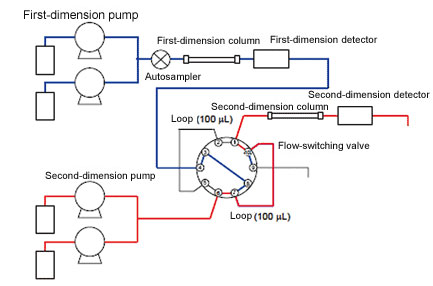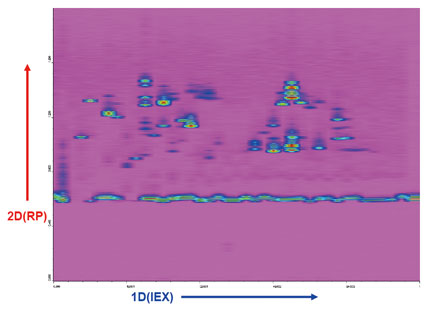About Comprehensive Two-Dimensional LC
What is Multidimensional Chromatography?
Multidimensional chromatography uses a combination of several chromatography techniques, separation modes, and columns to separate multiple components. It achieves significantly higher separation than normal one-dimensional chromatography. Various separation modes and the corresponding mobile phases can be selected for HPLC, and the diverse permutations available suggest the possibility of achieving a degree of selectivity not possible using one-dimensional separation alone.
Multidimensional chromatography includes an offline technique in which the eluent is temporarily fractioned (collected) in a suitable position and then part or all of it is injected into the next column, and an online technique in which part or all of the eluent is introduced into the column via the sample loop for automatic analysis. Offline multidimensional chromatography requires additional handling, such as elution by solvent and concentration of the temporarily fractioned (collected) eluent.
What is Comprehensive Two-Dimensional LC?
Two-dimensional LC is a commonly used HPLC multidimensional chromatography technique. It is sometimes called "LC×LC". One of the two-dimensional LC techniques is comprehensive two-dimensional LC, in which all the eluent from the first-dimension column is introduced online into the second-dimension column, such that the entire sample is subjected to two-dimensional separation.
System Configuration for Comprehensive Two-Dimensional LC
Fig. 1 shows the system configuration for comprehensive two-dimensional LC. This system permits gradient elution at both the first- and second-dimension stages. The sample solution is injected by the autosampler and separated in the first-dimension column. The sample flow rate is generally low in the first-dimension column (such as 50 μL/min) to allow separation over a long period of time. The eluent from the first column is sent to the loop of the flow-switching valve.
When the loop becomes full (after two minutes at a 50 μL/min flow rate with the 100 μL loop used in this example), the valve operates to send the eluent for separation in the second-dimension column. As the flow-switching valve operates every two minutes in the example shown here, analysis in the second-dimension column (including column equilibration time for gradient elution) must be completed within two minutes.
A UHPLC (ultra high performance liquid chromatography) column has been adopted in recent years as the second-dimension column in order to achieve a sufficiently high degree of separation in about one minute.

Fig. 1: Example of a System Configuration for Comprehensive Two-Dimensional LC
Comprehensive Two-Dimensional LC Analysis Example
Fig. 2 shows the analysis of a tryptic digest of bovine serum albumin using a comprehensive two-dimensional LC system. The sample was separated using an ion-exchange column (1 mm I.D.×50 mm long, 50 μL/min flow rate) as the first-dimension column and a reverse-phase column (2 mm I.D.×50 mm long, 600μL/min flow rate) as the second-dimension column.
The alignment of peaks in the vertical-axis (second-dimension) direction indicates separation of components in the second-dimension column that could not be separated in the first-dimension column. Therefore, it can be said that comprehensive two-dimensional LC is able to separate components at the second-dimension that could not be separated at the first-dimension.

Fig. 2: Analysis of Peptides by Comprehensive Two-Dimensional LC (Tryptic digest of bovine serum albumin)


